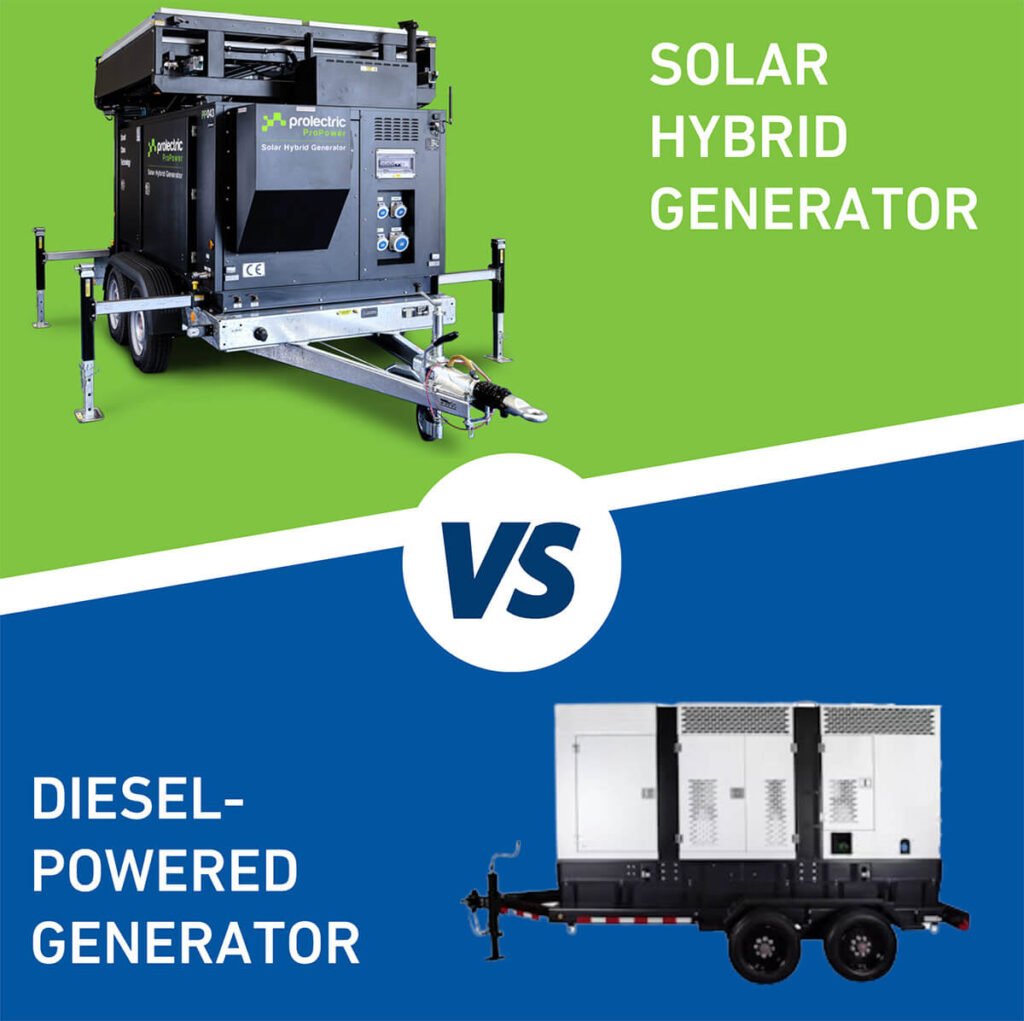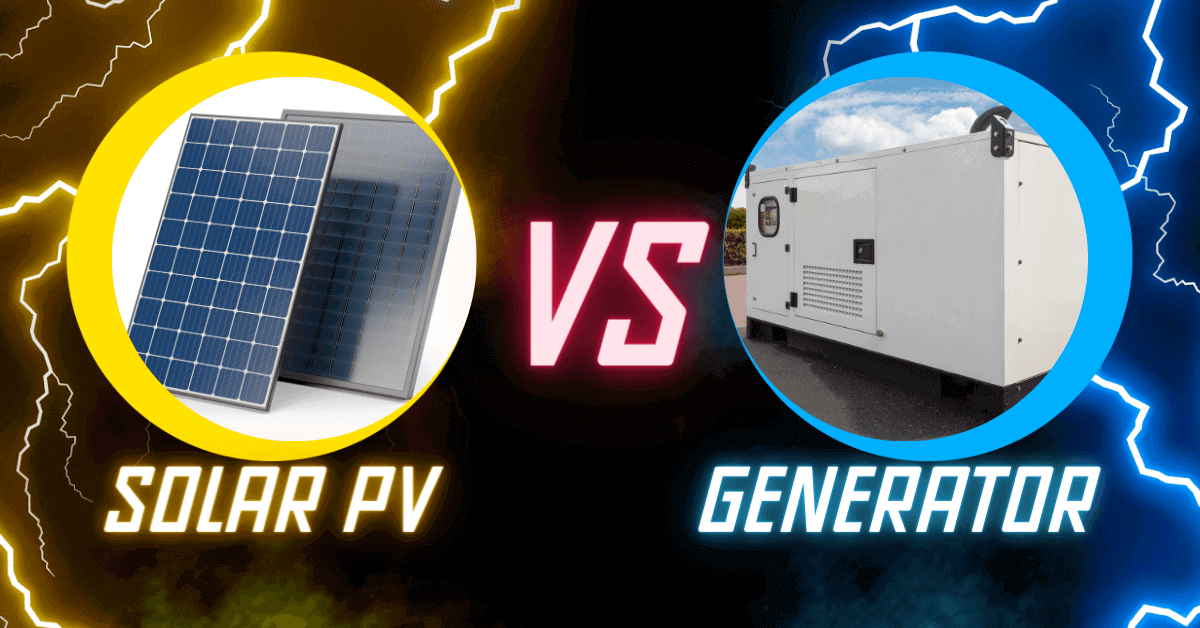Many Indian businesses still rely heavily on diesel generators (DGs) to keep operations running during power cuts. Diesel generators are quick, reliable, and can run anytime. But they come with high running costs and heavy emissions. On the other hand, commercial solar power systems are now cheaper, cleaner, and more popular than ever.
In this detailed guide, we will compare commercial solar power vs diesel generators from an Indian business perspective. We will look at installation cost, running cost, maintenance, emissions, and reliability so you can make an informed choice for your company.
Quick Summary: Solar vs Diesel Backup Power in India
- Diesel generators are cheaper to buy but very costly to run over time.
- Commercial solar energy systems need higher initial investment but have near-zero running costs.
- Diesel power costs in India can range between ₹25 to ₹40 per unit.
- Solar power is cleaner, reduces emissions, and is low maintenance.
- Over 5–10 years, solar can be far more economical for frequent backup use.
Upfront Installation Costs
Diesel generators are relatively cheap to purchase. A 100 kVA diesel generator is often cheaper than a 100 kW commercial solar plant with battery backup.
A commercial solar power system requires solar panels, inverters, mounting structures, cabling, and sometimes batteries. In India, costs can vary based on size and quality:
- Small commercial rooftop systems: ₹40,000–₹60,000 per kW (without batteries)
- Large industrial setups: ₹35,000–₹50,000 per kW (without batteries)
- Solar with batteries: higher costs due to storage needs
While diesel is cheaper upfront, solar power is an investment that pays off over years of free electricity generation.

Running Costs: Fuel vs Free Sunlight
This is where solar power shines.
Diesel generators need fuel every time they run. The cost per kWh from diesel can easily be ₹25–₹40 depending on diesel prices, efficiency, and usage hours. And remember—diesel prices in India have been rising steadily.
Commercial solar power uses free sunlight. Once installed, the “fuel” cost is practically zero. Even with battery systems, the cost per unit is far lower than diesel in the long run. For businesses using generators often, solar drastically reduces electricity bills.
Emissions: Diesel’s Dirty Secret
Diesel generators emit:
- Carbon dioxide (CO₂)
- Nitrogen oxides (NOx)
- Sulphur dioxide (SO₂)
- Particulate matter (PM2.5, PM10)
These pollutants harm air quality, cause respiratory diseases, and contribute to climate change. Indian cities already face severe air pollution—adding more diesel emissions only worsens the problem.
Solar power systems produce almost zero emissions while generating electricity, making them far better for both the environment and public health.
Also Read Shine Bright: The Ultimate Guide to Cleaning Solar Panels at Home in India
Reliability & Power Availability
Diesel Generators:
- Can run any time, day or night
- Provide instant backup power
- Need constant fuel supply
- Require regular servicing
Solar Power:
- Works best during the day
- Can power night loads with batteries or hybrid setups
- Requires little maintenance (cleaning panels and checking systems)
- Needs adequate sunlight and installation space
For 24/7 power needs, many Indian companies now use solar-diesel hybrid systems—solar during the day, diesel only when needed.
Total Cost of Ownership
When comparing solar and diesel over 10–20 years, you should factor in:
- Initial installation (CAPEX)
- Fuel costs (diesel) or energy yield (solar)
- Maintenance and servicing
- Component replacement (batteries, inverters)
- Pollution-related costs and compliance penalties
Studies show that for frequent backup use, solar plus storage can save lakhs of rupees over its lifetime compared to diesel generators.
Space & Installation Needs
- Solar power requires roof or land space (approx. 100 sq. ft. per kW).
- Diesel generators require less space but need proper ventilation, noise reduction, and fuel storage.
If you have unused rooftop space, it can be turned into a power-generating asset.
Maintenance
- Diesel: Oil changes, filter replacements, fuel checks every 250–500 hours.
- Solar: Occasional cleaning and inverter checks, with panel life of 20–30 years.
Over time, solar maintenance costs are far lower.
Government Policies & Incentives
India has strong renewable energy targets. Many states offer:
- Net metering
- Accelerated depreciation benefits for businesses
- Capital subsidies for certain categories
Switching to solar can also improve your company’s ESG (Environmental, Social, and Governance) profile.
When Diesel Still Makes Sense
While solar is the better choice for most, diesel is still useful for:
- Remote areas with poor sunlight
- Short-term emergency power
- Instant backup for sensitive equipment
Decision Checklist for Your Business
- How many hours per day do you use backup power?
- What is your diesel cost per litre?
- Do you have enough space for solar panels?
- Can you invest in upfront costs for long-term savings?
- Are emissions and compliance important to you?
- Would a solar-diesel hybrid work better for you?
FAQs
Q: How much does diesel generator electricity cost in India?
A: Around ₹25–₹40 per kWh, depending on fuel cost and generator efficiency.
Q: How much does commercial solar power cost per unit?
A: Once installed, solar costs ₹2–₹4 per kWh over its lifetime.
Q: Does solar work at night?
A: Only with battery storage or a grid connection.
Q: Can solar completely replace diesel?
A: In most commercial cases, a hybrid system is the most reliable.
Q: What’s the lifespan of solar panels?
A: 20–30 years with proper care.
Final Thoughts
Diesel generators are easy to install and reliable in emergencies, but they are expensive to run and polluting. Commercial solar power systems have higher upfront costs but save money for years and reduce diesel fuel consumption drastically.
For most Indian businesses, the best solution is a solar-first approach with diesel as a secondary backup. This ensures reliability, cost savings, and a cleaner future.










